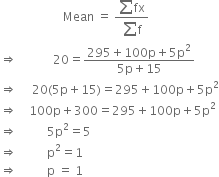Find the value of p if mean of following distribution is 20.
|
X |
f |
|
15 |
2 |
|
17 |
3 |
|
19 |
4 |
|
20 + p |
5p |
|
23 |
6 |
ol.
|
x |
f |
fx |
|
15 |
2 |
30 |
|
17 |
3 |
51 |
|
19 |
4 |
76 |
|
20 + p |
5p |
5p(20 + p) |
|
23 |
6 |
138 |
|
Total |
5p + 15 |
295 + l00p + 5p2 |




